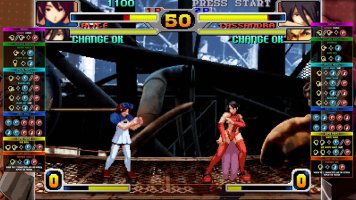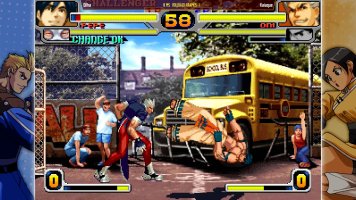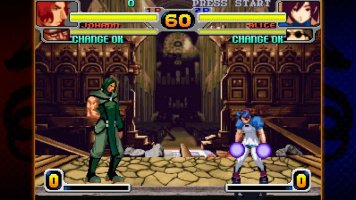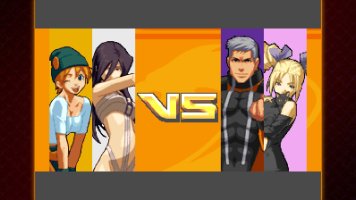Official Review
Game Overview and Legacy
Released in 2002, Rage of the Dragons emerged as a unique collaboration between Mexican and Japanese developers, creating one of the most distinctive entries in the Neo Geo's fighting game library. This dragons game represents a fascinating chapter in fighting game history, combining Eastern and Western design philosophies into a cohesive whole.
The Double Dragon Connection
What many players don't know is that Rage of the Dragons began life as an intended sequel to the 1995 Neo Geo fighting game version of Double Dragon. When Evoga couldn't secure the intellectual rights, they transformed their vision into a creative homage. The game's protagonists, Billy and Jimmy Lewis, mirror their Double Dragon counterparts, while other characters like Abubo and Linda serve as reimagined versions of classic Double Dragon fighters.Neo Geo Fighting Game Evolution
The game introduced several innovative features that set it apart from its contemporaries:- Tag-team combat system with real-time character switching
- Strategic "surrender" mechanic allowing health transfer between partners
- Launcher attacks with guided combo systems
- KOF-style rolls and defensive options
Development History
The creation of Rage of the Dragons stands as a testament to international collaboration in game development. Mexican studio Evoga handled the initial planning and character designs, while Japanese developer Noise Factory refined the graphics, sound, and programming. Character designer Mario Vargas and illustrator Bunshichirou Ohma brought a unique visual style that blended anime esthetics with Western influences.The game's artistic direction deserves special mention, featuring vibrant character designs from Lynn, the Chinese martial artist, to the Gothic lolita Annie. The soundtrack, composed by Toshikazu Tanaka, became renowned for its distinctive mix of guitar riffs and choral arrangements, despite the hardware limitations of the Neo Geo's sound system.
This collaborative effort resulted in a fighting game that, while perhaps not revolutionary in its mechanics, achieved excellence through its polished execution and distinctive style. The development team's passion for the project shines through in every aspect, from the fluid animation to the intricate combat system that rewards both casual players and dedicated fighting game enthusiasts.
Core Fighting Mechanics
At its core, Rage of the Dragons revolutionizes tag-team combat with an intricate yet approachable fighting system. The game's mechanical depth stems from its perfectly balanced combination of offensive and defensive options, creating engaging matches that reward both strategic thinking and technical execution.
Tag Team System Deep Dive
The tag team mechanics in this dragons game go beyond simple character switching. Players control two fighters, with the inactive character gradually recovering health while tagged out. The tag system requires careful management of the tag meter, which fills slowly over time. Strategic tagging isn't just about preservation—it's about creating devastating combo opportunities and saving partners from dangerous situations.Special Moves and Combos
The combat system utilizes a four-button layout:- Weak Punch and Kick (A and B buttons)
- Strong Punch and Kick (C and D buttons)
- Tag command (B+C combination)
- First Impact activation (C+D combination)
Strategic Depth Analysis
Combat depth extends beyond basic attacks through a robust defensive system. Players can perform:- Neutral dodges for attack avoidance
- Forward and backward rolls for positioning
- Strategic blocking against various attack heights
- Character-specific counter-attacks
The surrender mechanic introduces a fascinating risk-reward element, allowing players to sacrifice one character's remaining health to power up their partner. This creates dramatic comeback opportunities and forces players to make critical decisions under pressure.
Modern Features and Enhancements
The modern revival of this dragons game brings substantial quality-of-life improvements while preserving the charm of the original. QUByte Interactive has carefully enhanced the classic experience with features that both newcomers and veterans will appreciate.
Rollback Netcode Implementation
The implementation of rollback netcode marks a significant step forward for online play. Players can now enjoy smooth, responsive matches with minimal input delay. The online infrastructure supports:- Ranked and casual matchmaking
- 8-player lobbies for extended sessions
- Replay system with takeover functionality
- Comprehensive leaderboard tracking
Training Mode and Learning Tools
The extensive training mode serves as a comprehensive laboratory for mastering the game's mechanics. Players can practice their tag combinations, study frame data, and perfect their execution in a controlled environment. The new Dragon's Challenge mode introduces specialized scenarios that help players understand advanced techniques and team synergies.Quality of Life Improvements
Modern conveniences extend beyond the core gameplay experience. The addition of a customizable jukebox system allows players to select their preferred menu music, creating a personalized atmosphere between matches. The interface has been streamlined for modern displays while maintaining the classic esthetic that fans remember.The game offers over 80 team combinations in classic mode, each providing unique strategic possibilities. This variety is supported by intuitive menu navigation and quick character selection screens that streamline the pre-match experience. The training mode includes frame-by-frame movement analysis and hit-box visualization, tools that were unimaginable in the original release.
Filter options have been added to enhance the visual experience, allowing players to adjust the presentation to their preferences. Whether you're looking for a pristine modern look or the authentic feel of a CRT display, the visual options accommodate various tastes.
The developers have struck a careful balance between modernization and preservation. While the core gameplay remains true to the original, these quality-of-life improvements make the experience more accessible and enjoyable for today's audience. The combination of robust online features, comprehensive training tools, and thoughtful interface improvements creates a package that respects its legacy while embracing modern gaming standards.
Character Roster Analysis
The diverse roster of fourteen unique fighters forms the beating heart of this dragons game, each character bringing their own distinct fighting philosophy to the arena. From traditional martial artists to supernatural warriors, the cast offers a rich tapestry of combat styles that cater to various playstyles.
Fighter Archetypes and Playstyles
The roster encompasses several distinct fighting archetypes:- Radical Rushdown Fighters like Jimmy Lewis and Lynn Baker excel at overwhelming opponents with aggressive pressure and quick combinations
- Technical Grapplers such as Abubo Rao and Jae-mo Kang focus on devastating command throws and close-range dominance
- Strategic Zoners including Annie Murakami and Elias Patrick control space with long-range attacks
- Hybrid Fighters like Billy Lewis and Sonia Romanenko blend multiple styles for versatile gameplay
Team Synergy Breakdown
Team composition in Rage of the Dragons transcends mere character selection—it's about creating powerful synergistic combinations. The game offers seven default pairings, but the real depth comes from the nearly 80 possible custom combinations. Strategic team building revolves around complementary fighting styles and meter management.The Jimmy-Lynn pairing exemplifies classic rushdown synergy, while the Abubo-Pupa combination demonstrates the power of mixing grappler pressure with mobility. Teams can be built around various strategies:
- Offensive Pressure: Pairing rushdown characters for relentless assault
- Mixed Approach: Combining a zoner with a grappler for versatile options
- Technical Control: Two technical fighters for complex combo potential
Character Balance Assessment
While the roster shows impressive diversity, certain balance considerations emerge during high-level play. Alice Carroll's combo potential stands out, with some players noting the ease of executing high-damage combinations. The tag system's health recovery mechanic adds another layer to character balance, as some fighters benefit more from brief respites than others.The competitive viability of different team compositions varies significantly. Top-tier combinations typically feature at least one character with strong neutral game options, complemented by a partner who can capitalize on momentum shifts. However, the game's tag mechanics help mitigate character weaknesses, as strategic tagging can protect vulnerable fighters during unfavorable matchups.
The presence of powerful combo systems and super cancels creates interesting balance dynamics. While some characters like Alice can reliably convert hits into significant damage, others excel in neutral game control or resource management. This creates a meta where success depends not just on individual character strength, but on how well players can leverage team synergy to maximize their chosen fighters' potential.
Competitive Gaming Potential
The competitive landscape of this dragons game presents an intriguing mix of accessibility and depth, making it a unique entry in the fighting game tournament scene. While some veterans might find the combo system more straightforward than traditional Neo Geo titles, the strategic depth emerges through its innovative tag mechanics and team synergies.
Tournament Viability
The implementation of modern online infrastructure positions Rage of the Dragons NEO as a serious contender in the competitive fighting game space. The game supports:- Ranked matchmaking with comprehensive leaderboards
- Eight-player lobbies for tournament practice
- Replay system with match analysis capabilities
- Rollback netcode for consistent online performance
Community Resources
The development team has equipped players with comprehensive tools for competitive improvement. The Dragon Challenge mode serves as an excellent proving ground for aspiring competitors, while the extensive training mode facilitates precise practice sessions. The replay system goes beyond simple playback, offering detailed frame data and allowing players to take over matches at any point—a valuable tool for analyzing different approaches to specific situations.The game's competitive community benefits from:
- Integrated frame data display in training mode
- Character-specific combo challenges
- Situation-specific training scenarios
- Match replay analysis tools
- Online lobby practice sessions
Meta Development
The competitive meta continues to evolve as players explore the vast potential of team combinations. With over 80 possible team compositions, the strategic depth extends far beyond individual character mastery. The tag system's health recovery mechanic adds another layer of strategy, as players must balance aggressive pressure with defensive tagging to maintain team longevity.The First Impact system creates interesting competitive dynamics, as players must weigh the risk-reward of committing to extended combinations versus maintaining neutral positioning. The presence of strong defensive options, including rolls and dodges, prevents the meta from becoming overly aggressive, rewarding players who can effectively mix offensive pressure with patient neutral play.
Tournament-level play has revealed interesting strategic patterns, particularly in how top players utilize the surrender mechanic. This unique feature allows for dramatic comebacks and forces opponents to constantly re-evaluate their approach based on remaining team resources. The competitive scene has already begun developing optimal team compositions that balance neutral game control with combo potential, though the meta remains relatively young and continues to evolve.
The game's strategic depth is further enhanced by stage interactions, with breakable walls adding another layer of competitive consideration. High-level players must factor in stage positioning and wall-break opportunities when planning their approach, creating dynamic matches that extend beyond simple character matchups.
Conclusion
Rage of the Dragons NEO stands as a masterful revival that respects its Neo Geo roots while embracing modern fighting game standards. The refined tag-team system, paired with responsive rollback netcode, creates matches that feel both nostalgic and fresh. The game shines brightest through its strategic depth, offering players nearly 80 team combinations to explore and master.
The extensive training tools and quality-of-life improvements make this dragons game remarkably approachable for newcomers, yet the deep combat mechanics ensure veterans will find plenty to master. While some might debate the simplified combo system, the focus on strategic team building and resource management adds layers of complexity that keep matches engaging.
This revival proves that classic fighting games can thrive in the modern era when updated thoughtfully. The combination of robust online features, comprehensive training modes, and carefully balanced character roster makes Rage of the Dragons NEO a worthy addition to any fighting game enthusiast's collection.






